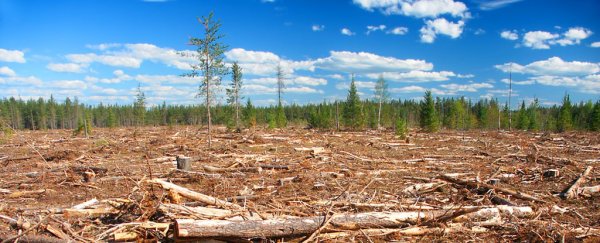Researchers have found that while the impact of human activity on the planet is continuing to grow, it's now doing so at a slower rate than our economic and population growth.
This means that humans are still taking over the planet at the expense of many species and the natural world at large, but the upside is that the slowdown gives us reason for hope, as it suggests we're getting better at managing what we take from the environment.
"Seeing that our impacts have expanded at a rate that is slower than the rate of economic and population growth is encouraging," said lead researcher Oscar Venter from the University of Northern British Columbia in Canada. "It means we are becoming more efficient in how we use natural resources."
The team, comprising researchers from the Wildlife Conservation Society (WCS) and eight universities from around the world, used satellite data and on-ground surveys to track how human activity altered natural habitats across the globe between 1993 and 2009.
In that relatively short timeframe, the global population grew 23 percent, and the global economy grew 153 percent, the researchers found. By contrast, the global human footprint grew only 9 percent in that time – still a troubling statistic, but at least it's markedly less than the population and economic growth.
The researchers think the increasing efficiency can be attributed to the Environmental Kuznets Curve (EKC) hypothesis, which suggests that environmental pressures are at their worst when industrial societies are in the early stages of development, but then begin to slow down relative to financial growth as markets modernise.
In other words, as countries around the world become more industrialised and developed, their human footprint starts to ease off.
But while that slower footprint growth is a silver lining of sorts, the overall picture of how much humanity has trampled all over the planet is more sobering.
"Our maps show that three quarters of the planet is now significantly altered and 97 percent of the most species-rich places on Earth have been seriously altered," said one of the team, James Watson from the University of Queensland in Australia. "There is little wonder there is a biodiversity crisis."
The researchers have made their data available online with an interactive website that allows you to compare the human footprint as it was in 1993 and how it looked by 2009, and lets you explore areas where human activity is putting increasing or decreasing pressure on the environment.
The maps track changes in the extent of built environments, cropland, and pasture land, plus monitor population density and human infrastructure such as night-time lights, railways, and roads.
The increasing human footprint means that habitats that once showed no sign of human activity are becoming smaller in area, albeit more slowly than they once were.
In 1993, approximately 27 percent of the world's non-Antarctic land area had no measurable human footprint – but the next 16 years saw our activity encroach upon some 23 million square kilometres (8.9 million square miles) of previously intact natural habitat.
And despite how scary that might sound, the good news is that, according to the findings, this kind of incursion is slowing down, meaning responsible environmental practices are making headway around the world.
"Sustainable development is a widely espoused goal, and our data demonstrates clear messages of how the world can get there," said Venter. "Concentrate people in towns and cities so their housing and infrastructure needs are not spread across the wider landscape, and promote honest governments that are capable of managing environmental impacts."
The researchers found that the most improvement was taking place in wealthy nations and places that had low levels of corruption. But on the other hand, because rich countries consume more than poor countries, they've actually got more ground to make up.
"In broad terms, industrial nations and those with lower corruption appear to be doing a better job of slowing the expansion of their human footprint than poorer countries with weak governance," said researcher Bill Laurance from James Cook University in Australia. "But the wealthy countries have a much higher per-capita footprint, so each person there is consuming a lot more than those in poorer nations."
The researchers hope that policy makers will use the maps and data to focus conservation efforts on the untouched habitat we have left, while working to remove existing pressures humans have placed upon the environment.
It's a big job, but at least we have a brilliant new map to help show the way.
"Humans are the most voracious consumers planet Earth has ever seen. With our land-use, hunting and other exploitative activities, we are now directly impacting three quarters of Earth's land surface," said Laurance. "The bottom line is that we need to slow rampant population growth, especially in Africa and parts of Asia, and demand that people in wealthy nations consume less."
The findings are reported in Nature Communications.
